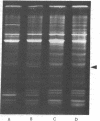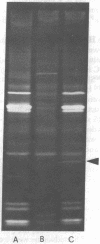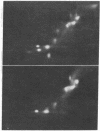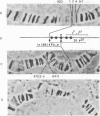Abstract
Drosophila melanogaster tissues carrying a third chromosome with the deletion Df(3R)KarD2 make a 40,000-dalton (Dal) heat shock protein not made by wild type. The unusual polypeptide was inducible in every tissue examined. Tryptic peptide fingerprints showed it to include part of the 70,000-Dal major heat shock protein. Mapping experiments placed the mutation responsible for the 40,000-Dal protein at or close to the karD2 deletion. One break point of the deletion is in subdivision 87A, close to or at a heat shock locus that codes for the 70,000-Dal protein. The results are consistent with the possibility that this break point is within a gene for the 70,000-Dal protein, leaving only the initial portion of its coding sequence. This would specify the direction of transcription of the mutant gene as proximal to distal on the normal chromosome. The 87A heat shock locus should contain at least two genes for the 70,000-Dal protein, because embryos homozygous for the karD2 deletion and lacking the heat shock locus at 87C, which also codes for the 70,000-Dal protein, nevertheless produced both the 40,000-Dal and the 70,000-Dal proteins upon temperature elevation. Using the presence of the 40,000-Dal protein to monitor chromosome segregation, we found that embryos homozygous for deletions of the heat shock puff site at 93D exhibited a normal electrophoretic pattern of heat shock proteins.
Keywords: heat shock puffs, abnormal polypeptide, chromosomal rearrangements
Full text
PDF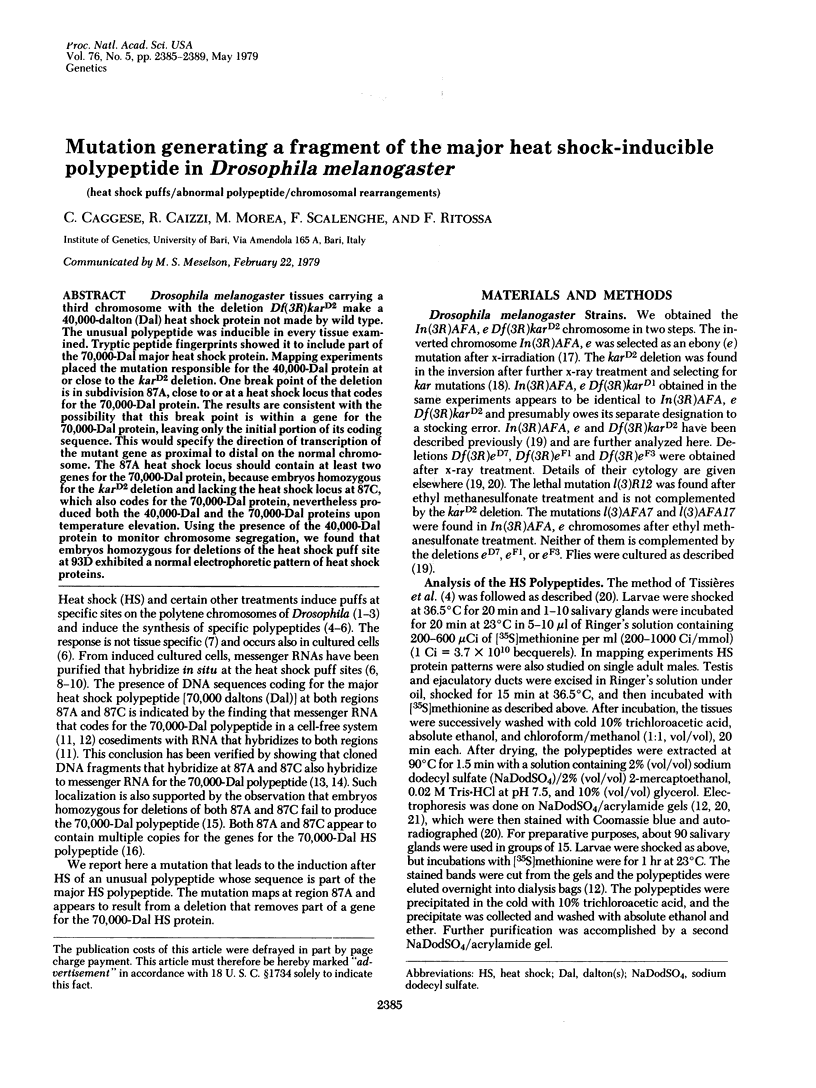
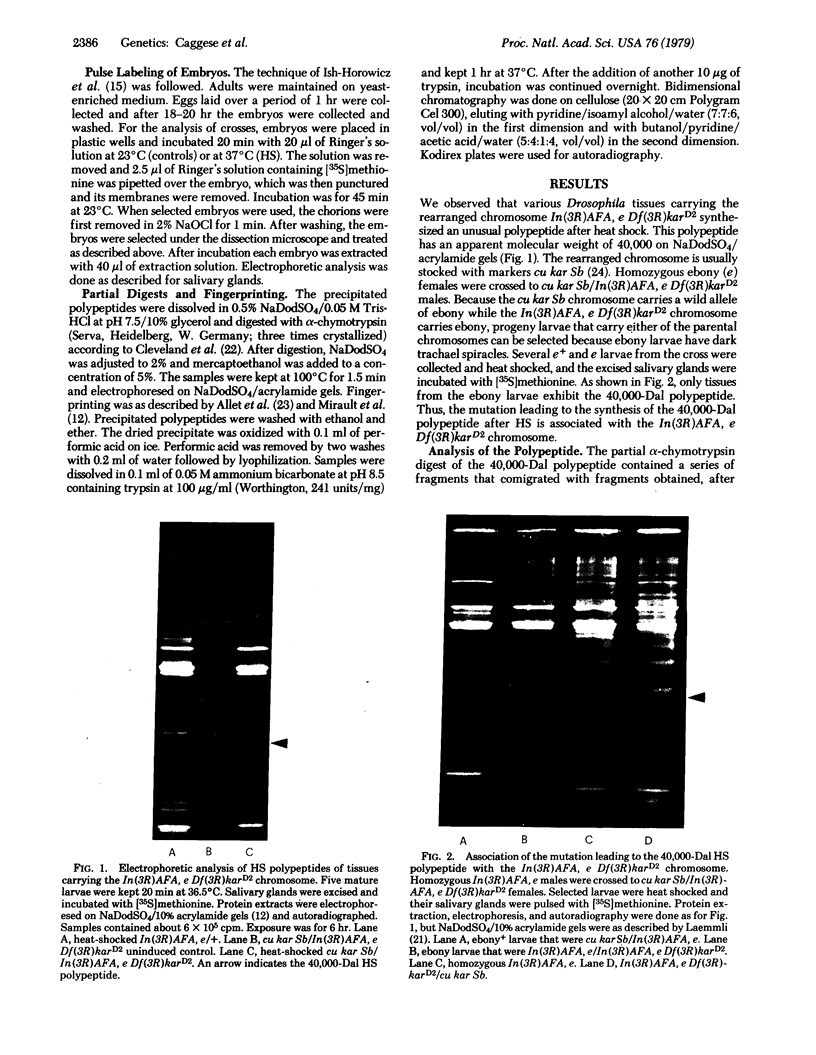
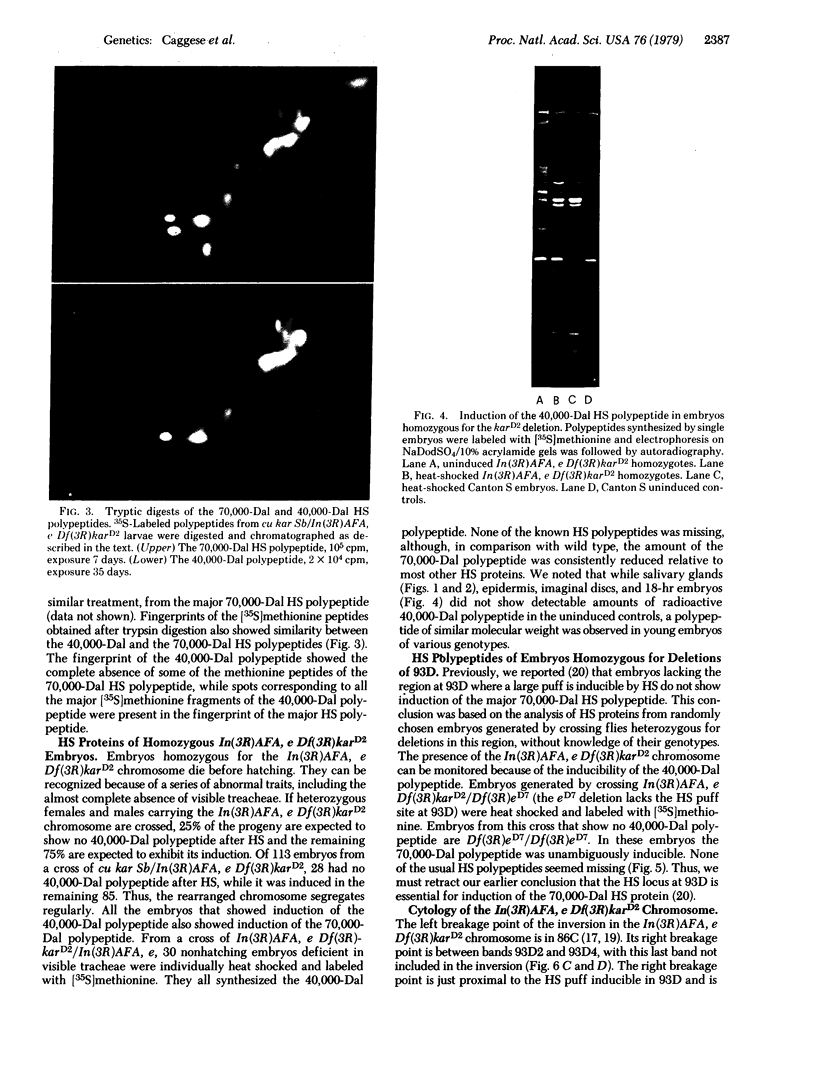
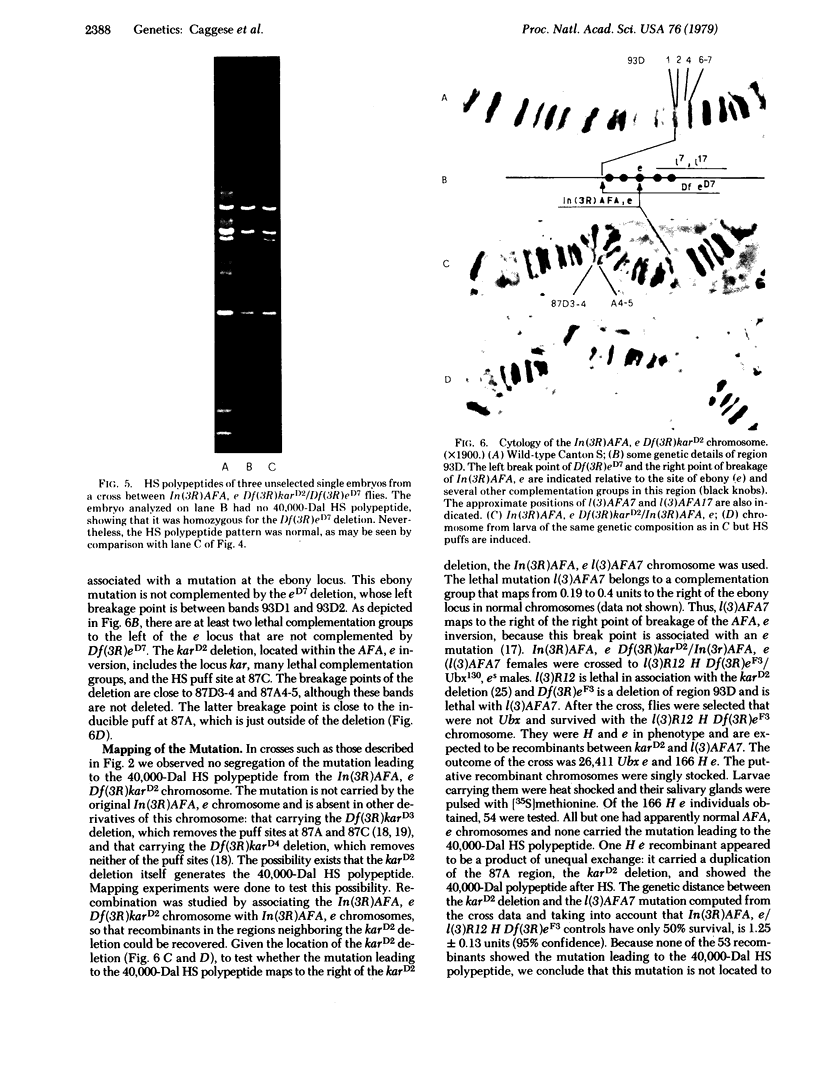
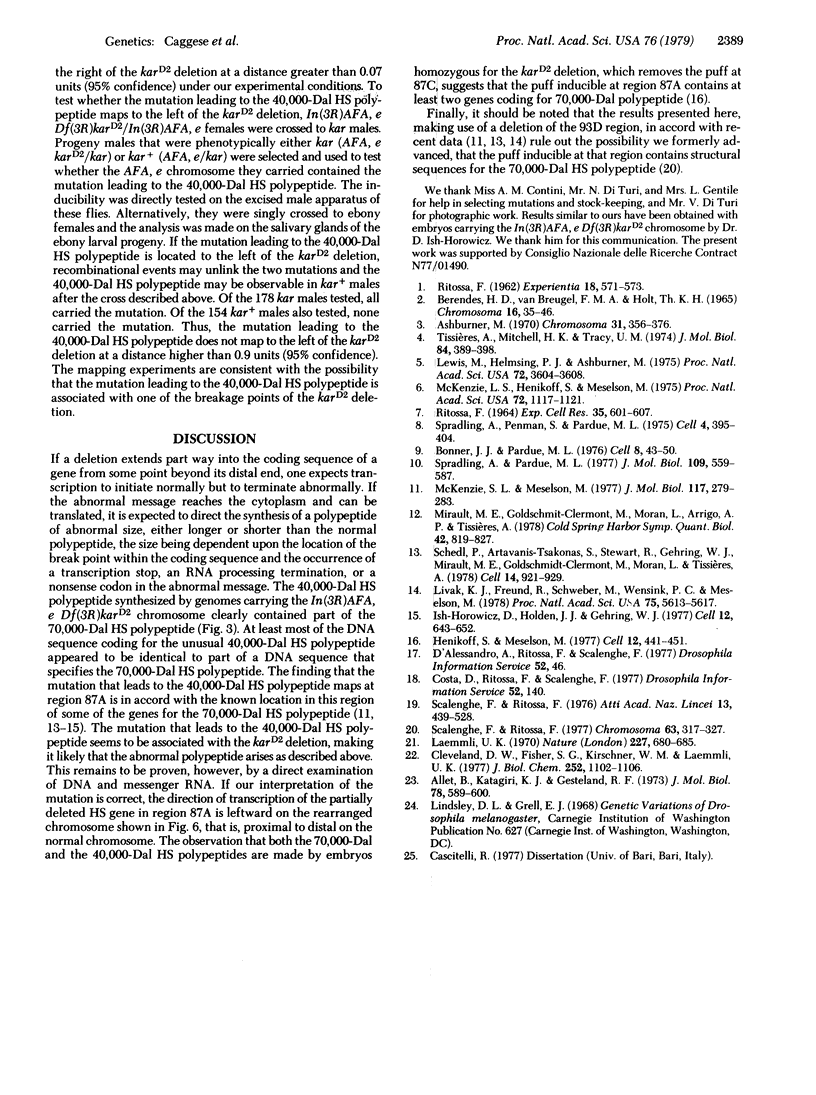
Images in this article
Selected References
These references are in PubMed. This may not be the complete list of references from this article.
- Allet B., Katagiri K. J., Gesteland R. F. Characterization of polypeptides made in vitro from bacteriophage lambda DNA. J Mol Biol. 1973 Aug 25;78(4):589–600. doi: 10.1016/0022-2836(73)90281-7. [DOI] [PubMed] [Google Scholar]
- Ashburner M. Patterns of puffing activity in the salivary gland chromosomes of Drosophila. V. Responses to environmental treatments. Chromosoma. 1970;31(3):356–376. doi: 10.1007/BF00321231. [DOI] [PubMed] [Google Scholar]
- BERENDES H. D., VAN BREUGELF, HOLT T. K. EXPERIMENTAL PUFFS IN SALIVARY GLAND CHROMOSOMES OF DROSOPHILA HYDEI. Chromosoma. 1965 Jan 30;16:35–46. doi: 10.1007/BF00320559. [DOI] [PubMed] [Google Scholar]
- Bonner J. J., Pardue M. L. The effect of heat shock on RNA synthesis in Drosophila tissues. Cell. 1976 May;8(1):43–50. doi: 10.1016/0092-8674(76)90183-5. [DOI] [PubMed] [Google Scholar]
- Cleveland D. W., Fischer S. G., Kirschner M. W., Laemmli U. K. Peptide mapping by limited proteolysis in sodium dodecyl sulfate and analysis by gel electrophoresis. J Biol Chem. 1977 Feb 10;252(3):1102–1106. [PubMed] [Google Scholar]
- Henikoff S., Meselson M. Transcription at two heat shock loci in Drosophila. Cell. 1977 Oct;12(2):441–451. doi: 10.1016/0092-8674(77)90120-9. [DOI] [PubMed] [Google Scholar]
- Ish-Horowicz D., Holden J. J., Gehring W. J. Deletions of two heat-activated loci in Drosophila melanogaster and their effects on heat-induced protein synthesis. Cell. 1977 Nov;12(3):643–652. doi: 10.1016/0092-8674(77)90264-1. [DOI] [PubMed] [Google Scholar]
- Laemmli U. K. Cleavage of structural proteins during the assembly of the head of bacteriophage T4. Nature. 1970 Aug 15;227(5259):680–685. doi: 10.1038/227680a0. [DOI] [PubMed] [Google Scholar]
- Lewis M., Helmsing P. J., Ashburner M. Parallel changes in puffing activity and patterns of protein synthesis in salivary glands of Drosophila. Proc Natl Acad Sci U S A. 1975 Sep;72(9):3604–3608. doi: 10.1073/pnas.72.9.3604. [DOI] [PMC free article] [PubMed] [Google Scholar]
- Livak K. J., Freund R., Schweber M., Wensink P. C., Meselson M. Sequence organization and transcription at two heat shock loci in Drosophila. Proc Natl Acad Sci U S A. 1978 Nov;75(11):5613–5617. doi: 10.1073/pnas.75.11.5613. [DOI] [PMC free article] [PubMed] [Google Scholar]
- McKenzie S. L., Henikoff S., Meselson M. Localization of RNA from heat-induced polysomes at puff sites in Drosophila melanogaster. Proc Natl Acad Sci U S A. 1975 Mar;72(3):1117–1121. doi: 10.1073/pnas.72.3.1117. [DOI] [PMC free article] [PubMed] [Google Scholar]
- McKenzie S. L., Meselson M. Translation in vitro of Drosophila heat-shock messages. J Mol Biol. 1977 Nov 25;117(1):279–283. doi: 10.1016/0022-2836(77)90035-3. [DOI] [PubMed] [Google Scholar]
- Mirault M. E., Goldschmidt-Clermont M., Moran L., Arrigo A. P., Tissières A. The effect of heat shock on gene expression in Drosophila melanogaster. Cold Spring Harb Symp Quant Biol. 1978;42(Pt 2):819–827. doi: 10.1101/sqb.1978.042.01.082. [DOI] [PubMed] [Google Scholar]
- RITOSSA F. M. EXPERIMENTAL ACTIVATION OF SPECIFIC LOCI IN POLYTENE CHROMOSOMES OF DROSOPHILA. Exp Cell Res. 1964 Sep;35:601–607. doi: 10.1016/0014-4827(64)90147-8. [DOI] [PubMed] [Google Scholar]
- Schedl P., Artavanis-Tsakonas S., Steward R., Gehring W. J., Mirault M. E., Goldschmidt-Clermont M., Moran L., Tissières A. Two hybrid plasmids with D. melanogaster DNA sequences complementary to mRNA coding for the major heat shock protein. Cell. 1978 Aug;14(4):921–929. doi: 10.1016/0092-8674(78)90346-x. [DOI] [PubMed] [Google Scholar]
- Spradling A., Pardue M. L., Penman S. Messenger RNA in heat-shocked Drosophila cells. J Mol Biol. 1977 Feb 5;109(4):559–587. doi: 10.1016/s0022-2836(77)80091-0. [DOI] [PubMed] [Google Scholar]
- Spradling A., Penman S., Pardue M. L. Analysis of drosophila mRNA by in situ hybridization: sequences transcribed in normal and heat shocked cultured cells. Cell. 1975 Apr;4(4):395–404. doi: 10.1016/0092-8674(75)90160-9. [DOI] [PubMed] [Google Scholar]
- Tissières A., Mitchell H. K., Tracy U. M. Protein synthesis in salivary glands of Drosophila melanogaster: relation to chromosome puffs. J Mol Biol. 1974 Apr 15;84(3):389–398. doi: 10.1016/0022-2836(74)90447-1. [DOI] [PubMed] [Google Scholar]



